Sword guide. History of sword. Sword parts and types of swords. European swords, Oriental swords, Japanese swords. Chinese swords. Ancient swords, medieval swords, renaissance rapier swords. Modern military swords.Sword
Sword is a weapon consisting typically of a long, straight or slightly curved, pointed blade having one or two cutting edges and set into a hilt. Sword was often symbol of a military, warrior class or an office. In mythology, sword was often symbol of divine power, symboil of various gods and often symbol of justice.
Sword parts
Parts of European medieval sword:

Parts of Japanese sword:
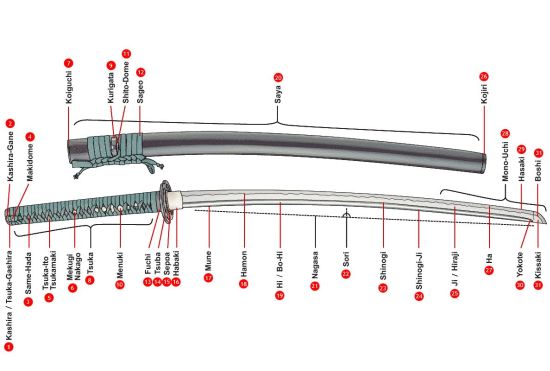
Sword history
Short historical sword guide. The most significant sword types in various historical periods. Ancient swords, medieval swords, renaissance swords, military swords. European and oriental sword types. Japanese swords, Chinese swords, Arabic swords.
ANCIENT SWORDS
(3500 BC-500 AD)
Roman swords
Roman armies used shorter Gladius sword and longer Spatha.
Roman gladius sword
Gladius was short Roman sword used by foot soldiers mostly for stabbing. Average length was 64–81 cm (25–32 in). Gladius was double edged sword with sharp tip and often ornated hilt.
Gladius types: Pompeii gladius (the most popular, latest), Mainz gladius, Hispaniensis gladius (eldest model) and Fulham gladius.
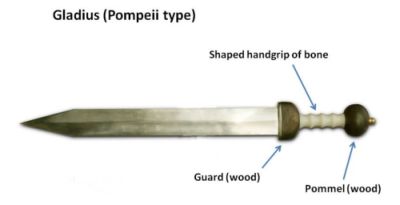
Roman spatha sword
Spatha was longer than gladius, 0.75 and 1 m (30 and 39 in), primarily used by Roman cavalry but also by a heavy infantry. Later viking swords are very similar to Spatha.
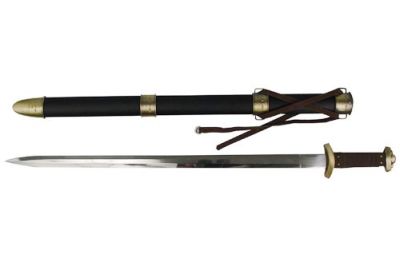
Greek swords
Greek swords contains kopis, xiphos and makhaira.
Kopis sword was one handed sword with blade length 48-65 cms. Kopis probably evolved from a knives. Kopis sword is similar to Iberian falcata sword.
Xiphos sword was more straight, double edged weapon. Xiphos was favourited by Greek hoplites. Kopis was more suitable for mounted combat.
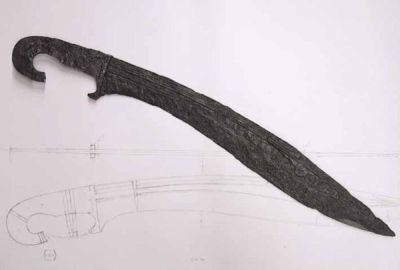
Egyptian swords
Khopesh-Egyptian sword
Khopesh was a sickle sword known in ancient Egypt and Mesopotamia. The sword was originally made of bronze and later from steel.
Khoesh was usually blunt, the sword was often used as a hook to remove shield of opponent. Khopesh sword was 50–60 cm (20–24 inches) long weapon.

Celtic swords
Celtic tribes used the iron swords from 5th century BC. Celts used generally two types of swords: Long and short swords. Swords were later substituted by daggers. Roman spatha sword probably evolved from Celtic sword and medieval swords (viking swords) evolved from spatha.
Celtic long sword is most commonly known for it’s anthropomorphic hilt, this is often made of an organic material such as horn, bone or even wood. In front of the guard was often found an iron plate shaped to match the mouth of the scabbard.
Celtic short sword – only difference was that it had an abstract or anthropomorphic hilt made out of copper alloy.
The Celts often decorated the hilts with Amber, ivory or gold leaf.
Celtic scabbards were generally made from two plates of iron, and suspended from a belt made of iron links. Some scabbards had front plates of bronze rather than iron.
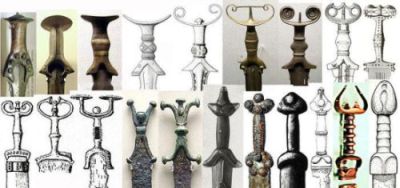
MEDIEVAL SWORDS
(500 AD-1500 AD)
Viking sword
The sword used by Germanic tribes in Scandinavia. The viking sword evolved from Roman spatha.

Medieval one handed sword
Common medieval sword of various shapes often used together with a shield.
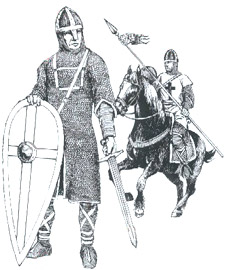
Medieval hand and a half sword
Bastard sword was longer than one handed sword. The sword gave an advantage to footmen against heavily armed medieval knights. One hand worn sword handle the second worn sword pommel.
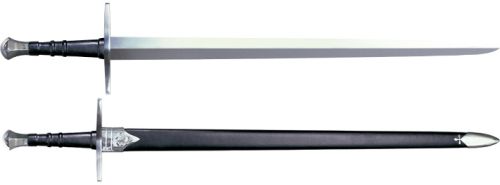
Medieval two handed sword
Sword worn in two hands. Large medieval sword evolved in Scottland.
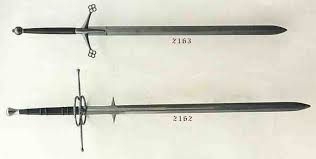
Medieval sword types by Oakeshott:

Renaissance rapier
(1500AD-1750AD)
Rapier sword originated in Italy and Spain during renaissance times and it lasted till 18th century. Rapier was substituted by small sword.
Rapiers were made in many variations. The differnece was in hilt and blade. Some rapiers used flat blade, other rapiers contained triangular blade.
Some rapiers were used as a stabbing weapon of gentlemen in duels other rapiers were heavier swords used as a slashing weapons against armor of enemies (30 years war).
Rapier types by hilt: cup hilt rapier, swept hilt rapier, Pappenheimer rapier (German).

Court sword
The court sword, also known as the small sword, was a light, one-handed sword developed in France during the late Renaissance period.
The blade is designed for thrusting rather than slashing, owing its heritage to the longer and heavier rapier and leading to the development of the foil and then the épée, and also the French classical school of fencing.
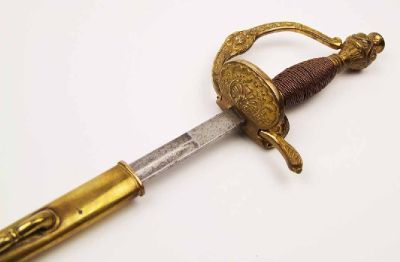
Military swords
Military swords are sabres or a straight swords used mostly during 19th century. Current military swords serving for a various ceremonial purposes.
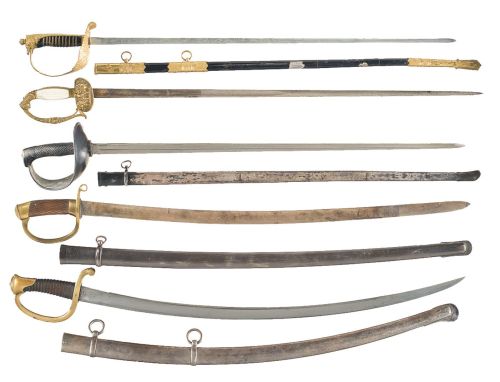
JAPANESE SWORDS
Tachi sword
Tachi sword is more curved than katana. Tachi was predecesor of katana swords and it was used by mounted samurais.
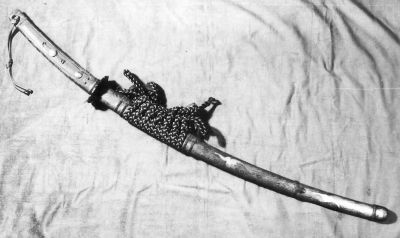
Katana sword
Katana is the most famous and common samurai sword. Slightly curved, single edged, two handed sword with a round or square guard. Lenth of katana blade is 60–73 cm (23 5⁄8–28 3⁄4 in). Chisa katana is shorter katana sword, O Katana means longer katana.
Katana, wakizashi and tanto on the picture:
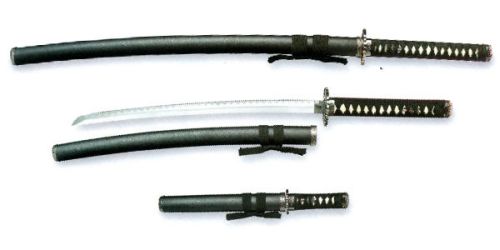
Wakizashi sword
Wakizashi is a short sword used as backup sword often for close combat or as a ritual weapon during harakiri (seppuku, suicide). Sword length was between 30 and 60 cm (12 and 24 in).
Nodachi sword
Nodachi (Odachi) is Japanese two handed great sword. The sword was historically used only rarely.
Tanto
Tanto is Japanese samurai dagger.
Gunto sword
Gunto is Japanese military sword used in pre ww2 and during ww2 by Japanese army and navy.
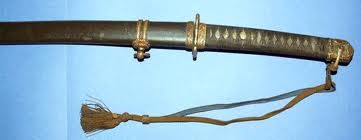
CHINESE SWORDS
Dao sword
Dao is curved Chinese sword witha wide blade (broadsword).
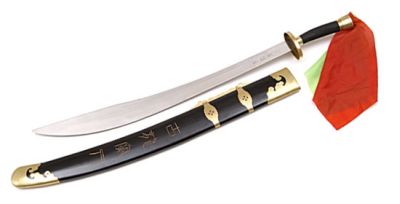
Jian sword
Jian is straight, double edged sword used by one or two hands.
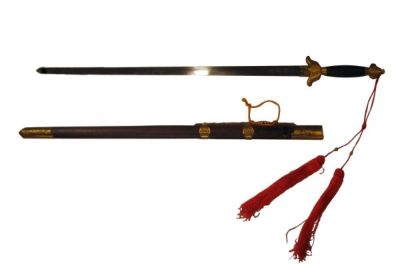
ORIENTAL SWORS
Arabic, Turkish, Indian and Persian swords
Persian shamshir
Arabic saif
Indian talwar
Turkish kilij

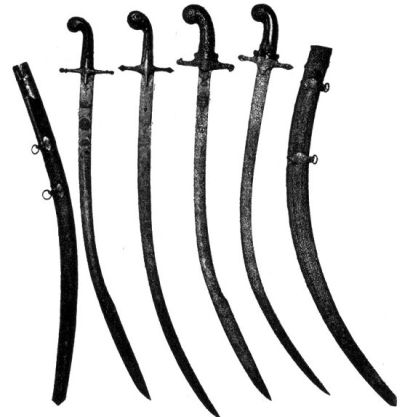
purchased two Spanish Toledo swords at estate sell have small shields in embellishment on top of sword they are in the Charles v design have two faces at ends of hilt. Engraved upper blade design with 2 different crest in them curious of value and age and how do I clean?